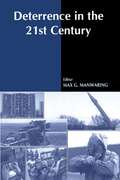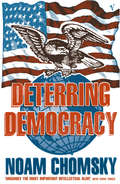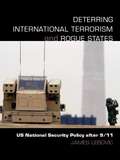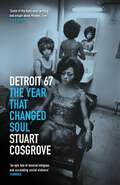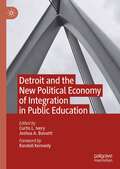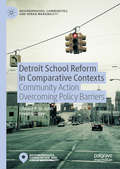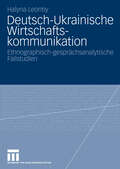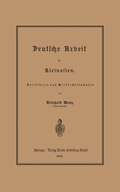- Table View
- List View
Deterrence in the Twenty-first Century
by Max G. ManwaringThis anthology argues that facing the diverse threats in the 'new world disorder' requires a new look and new approaches. The requirement is to establish that contemporary deterrence demands replacing the old 'nuclear theology' with new policy and strategy to deal with the myriad state, non-state, and trans-national nuclear and non-nuclear menaces that have heretofore been ignored or wished away.
Deterrence in the Twenty-first Century
by Max G. ManwaringThis anthology argues that facing the diverse threats in the 'new world disorder' requires a new look and new approaches. The requirement is to establish that contemporary deterrence demands replacing the old 'nuclear theology' with new policy and strategy to deal with the myriad state, non-state, and trans-national nuclear and non-nuclear menaces that have heretofore been ignored or wished away.
Deterrence, Reputation and Cold-War Cycles
by John D. OrmeA historical reexamination of the Cold War's cyclical pattern. It aims to show how Soviet aggressiveness was most likely to occur when the credibility of US efforts at deterrence was damaged by the inability or unwillingness of the US to meet previous challenges.
Deterring Armageddon: A Biography of NATO
by Peter Apps'HUGELY IMPRESSIVE' - THE INDEPENDENTThe history of the world's most successful military alliance, from the wrecked Europe of 1945 to Vladimir Putin's invasion of Ukraine.As they signed NATO into being after World War II, its founders fervently believed that only if the West's democracies banded permanently together could they avoid a catastrophic global atomic conflict. Over the 75 years since, the alliance has indeed avoided war with Russia, also becoming a major political, strategic and diplomatic player well beyond its borders. It has survived disagreements between leaders from Eisenhower, Churchill and de Gaulle to Trump, Stoltenberg and Merkel, faced down Kremlin foes from Stalin to Putin and endured unending questions and debate over what new nations might be allowed to join.Deterring Armageddon takes the reader from backroom deals that led to NATO's creation, through the Cold War, the Balkans and Afghanistan to the current confrontation with the Kremlin following the invasion of Ukraine. It examines the tightrope walked by alliance leaders between a powerful United States sometimes flirting with isolationism and European nations with their ever-evolving wishes for autonomy and influence. Having spent much of its life preparing for conflicts that might never come, NATO has sometimes found itself in wars that few had predicted - and with its members now again planning for a potential major European conflict.It is a tale of tension, danger, rivalry, conflict, big personalities and high-stakes military and diplomatic posturing - as well as espionage, politics and protest. From the Korean War to the pandemic, the Berlin and Cuba crises to the chaotic evacuation from Kabul, Deterring Armageddon tells how the alliance has shaped and been shaped by history - and looks ahead to what might be the most dangerous era it has ever faced.'Utterly eye-opening - compelling, haunting and continually illuminating. As Peter Apps so brilliantly demonstrates in this gripping book, the story of the NATO alliance is in many ways a parallel global history of the last 75 years. As well as all the outbreaks of seething tension between the US and its European allies - and the counter-moves of rival powers - this is also an account of just how often in those postwar years that we all stood on the edge of the most terrible abyss. With mesmerising fluency, and dazzling research, Apps follows the criss-crossing threads of the Cold War and beyond. Those threads converge in our shadowed present, and the conflict in Ukraine. In order to fathom today's dark world, Apps has explored a labyrinth of once-classified history, and he brings dazzling clarity.' - Sinclair McKay
Deterring Cyber Warfare: Bolstering Strategic Stability in Cyberspace
by Brian M. Mazanec B. ThayerWhile the deterrence of cyber attacks is one of the most important issues facing the United States and other nations, the application of deterrence theory to the cyber realm is problematic. This study introduces cyber warfare and reviews the challenges associated with deterring cyber attacks, offering key recommendations to aid the deterrence of major cyber attacks.
Deterring Democracy (Serie General/crítica Ser. #Vol. 222)
by Noam ChomskyFrom World War II until the 1980s, the United States reigned supreme as both the economic and the military leader of the world. The major shifts in global politics that came about with the dismantling of the Eastern Bloc have left the United States unchallenged as the pre-eminent military power, but American economic might has declined drastically in the face of competition, first from Germany and Japan and more recently from the newly prosperous countries elsewhere.In this book, Noam Chomsky points to the potentially catastrophic consequences of this imbalance. He reveals a world in which the United States exploits its advantage ruthlessly to enforce its national interests - and in the process destroys weaker nations.Deterring Democracy offers a devastating analysis of American Imperialism, drawing alarming connections between its repression of information inside the US and its aggressive empire-building abroad.
Deterring International Terrorism and Rogue States: US National Security Policy after 9/11 (Contemporary Security Studies)
by James H. LebovicThis new study challenges the widely held view that many current US adversaries cannot be deterred, maintaining that deterrence is not a relic of the Cold War period and that it should shape US policies toward so-called ‘rogue states’ and terror groups. James Lebovic argues that deterrence principles continue to apply, and focuses upon the ‘three pillars’ of the Bush administration’s national security policy: missile defence, which preoccupied the administration until September 11, 2001 pre-emption, which became the US focus with the September 11 attacks and US success in overthrowing the Taliban regime in Afghanistan homeland security, which the administration has portrayed as more a natural response to threat than an aspect of policy that must be reconciled with the other pillars. Deterring International Terrorism and Rogue States asserts that bad offences and defences have been endemic to the current US policy approach, leading US policy makers to pursue policies that require them to do everything without adequate concern for resource trade-offs, overreach, and unintended consequences. This book will be of great interest to students of US foreign policy, national and international security, terrorism and international relations in general.
Deterring International Terrorism and Rogue States: US National Security Policy after 9/11 (Contemporary Security Studies)
by James H. LebovicThis new study challenges the widely held view that many current US adversaries cannot be deterred, maintaining that deterrence is not a relic of the Cold War period and that it should shape US policies toward so-called ‘rogue states’ and terror groups. James Lebovic argues that deterrence principles continue to apply, and focuses upon the ‘three pillars’ of the Bush administration’s national security policy: missile defence, which preoccupied the administration until September 11, 2001 pre-emption, which became the US focus with the September 11 attacks and US success in overthrowing the Taliban regime in Afghanistan homeland security, which the administration has portrayed as more a natural response to threat than an aspect of policy that must be reconciled with the other pillars. Deterring International Terrorism and Rogue States asserts that bad offences and defences have been endemic to the current US policy approach, leading US policy makers to pursue policies that require them to do everything without adequate concern for resource trade-offs, overreach, and unintended consequences. This book will be of great interest to students of US foreign policy, national and international security, terrorism and international relations in general.
Deterring Russia in Europe: Defence Strategies for Neighbouring States (Contemporary Security Studies)
by Nora Vanaga Toms RostoksThis edited volume examines deterrence and the defense efforts of European states neighboring Russia, following the Crimean intervention. Deterrence, after being largely absent from debates among academics and policy-makers for almost a quarter of a century, has made a comeback in Europe. Since Russia’s annexation of Crimea and the start of the military conflict in Ukraine’s Donbass region, eastern and northern European states have revised their assessments of Russia’s policies and intentions. The approach used by Russia in Ukraine has rendered lessons learned from the Cold War deterrence only partially applicable due to the changing security situation in Europe. The emergence of the cyber realm, a smaller emphasis on nuclear deterrence, and the ideological conflict between Russia and the West, are among the key differences between the Cold War and the current security environment. Structured into two parts, the first part discusses conceptual aspects of deterrence, while the second discusses ten country case studies, which include both NATO and non-NATO countries. This allows for an in-depth analysis of the changing character of deterrence and its practical application by Russia’s European neighbours. This volume will be of much interest to students of strategic studies, European politics, Russian foreign policy, security studies and international relations in general.
Deterring Russia in Europe: Defence Strategies for Neighbouring States (Contemporary Security Studies)
by Nora Vanaga Toms RostoksThis edited volume examines deterrence and the defense efforts of European states neighboring Russia, following the Crimean intervention. Deterrence, after being largely absent from debates among academics and policy-makers for almost a quarter of a century, has made a comeback in Europe. Since Russia’s annexation of Crimea and the start of the military conflict in Ukraine’s Donbass region, eastern and northern European states have revised their assessments of Russia’s policies and intentions. The approach used by Russia in Ukraine has rendered lessons learned from the Cold War deterrence only partially applicable due to the changing security situation in Europe. The emergence of the cyber realm, a smaller emphasis on nuclear deterrence, and the ideological conflict between Russia and the West, are among the key differences between the Cold War and the current security environment. Structured into two parts, the first part discusses conceptual aspects of deterrence, while the second discusses ten country case studies, which include both NATO and non-NATO countries. This allows for an in-depth analysis of the changing character of deterrence and its practical application by Russia’s European neighbours. This volume will be of much interest to students of strategic studies, European politics, Russian foreign policy, security studies and international relations in general.
Deterring Terrorism: A Model for Strategic Deterrence (Contemporary Terrorism Studies)
by Elli LiebermanThis book examines the question of how to deter a non-state terrorist actor. Can terrorism be deterred? This book argues that current research is unable to find strong cases of deterrence success, because it uses a flawed research design which does not capture the longitudinal dynamics of the process. So far, the focus of inquiry has been on the tactical elements of a state’s counterterrorism strategy, instead of the non-state actor’s grand strategies. By studying the campaigns of Hezbollah, the Palestinians, the Irish Republican Army, Chechens, the Kurdistan Workers' Party, and Al-Qaeda/Taliban and ISIS over time, we can see that deterrence strategies that target the cost-benefit calculus of terrorist organizations lead to wars of attrition – which is the non-state organization’s strategy for victory. To escape the attrition trap, the state must undermine the attrition strategy of terrorist organizations by using offensive campaigns that become critical educational moments. The case studies presented here uncover an evolutionary process of learning, leading to strategic deterrence successes. Some terrorist organizations abandoned the use of force altogether, while others abandoned their aspirational goals or resorted to lower levels of violence. These findings should enable policymakers to transition from the failed policy that sought to defeat the Taliban and al-Qaeda in the unending war in Afghanistan to a policy that successfully applies deterrence. This book will be of much interest to students of deterrence theory, terrorism studies, war and conflict studies, and security studies.
Deterring Terrorism: A Model for Strategic Deterrence (Contemporary Terrorism Studies)
by Elli LiebermanThis book examines the question of how to deter a non-state terrorist actor. Can terrorism be deterred? This book argues that current research is unable to find strong cases of deterrence success, because it uses a flawed research design which does not capture the longitudinal dynamics of the process. So far, the focus of inquiry has been on the tactical elements of a state’s counterterrorism strategy, instead of the non-state actor’s grand strategies. By studying the campaigns of Hezbollah, the Palestinians, the Irish Republican Army, Chechens, the Kurdistan Workers' Party, and Al-Qaeda/Taliban and ISIS over time, we can see that deterrence strategies that target the cost-benefit calculus of terrorist organizations lead to wars of attrition – which is the non-state organization’s strategy for victory. To escape the attrition trap, the state must undermine the attrition strategy of terrorist organizations by using offensive campaigns that become critical educational moments. The case studies presented here uncover an evolutionary process of learning, leading to strategic deterrence successes. Some terrorist organizations abandoned the use of force altogether, while others abandoned their aspirational goals or resorted to lower levels of violence. These findings should enable policymakers to transition from the failed policy that sought to defeat the Taliban and al-Qaeda in the unending war in Afghanistan to a policy that successfully applies deterrence. This book will be of much interest to students of deterrence theory, terrorism studies, war and conflict studies, and security studies.
Deterring Terrorism: Theory and Practice
by Andreas Wenger Alex WilnerDuring the Cold War, deterrence theory was the cornerstone of U.S. foreign policy. Following the 9/11 terrorist attacks, however, popular wisdom dictated that terrorist organizations and radical fanatics could not be deterred—and governments shifted their attention to combating terrorism rather than deterring it. This book challenges that prevailing assumption and offers insight as to when and where terrorism can be deterred. It first identifies how and where theories of deterrence apply to counterterrorism, highlighting how traditional and less-traditional notions of deterrence can be applied to evolving terrorist threats. It then applies these theoretical propositions to real-world threats to establish the role deterrence has within a dynamic counterterrorism strategy—and to identify how metrics can be created for measuring the success of terrorism deterrence strategies. In sum, it provides a foundation for developing effective counterterrorism policies to help states contain or curtail the terrorism challenges they face.
Detroit: Three Pathways to Revitalization
by Lewis D. SolomonAs America's most dysfunctional big city, Detroit faces urban decay, population losses, fractured neighborhoods with impoverished households, an uneducated, unskilled workforce, too few jobs, a shrinking tax base, budgetary shortfalls, and inadequate public schools. Looking to the city's future, Lewis D. Solomon focuses on pathways to revitalizing Detroit, while offering a cautiously optimistic viewpoint.Solomon urges an economic development strategy, one anchored in Detroit balancing its municipal and public school district's budgets, improving the academic performance of its public schools, rebuilding its tax base, and looking to the private sector to create jobs. He advocates an overlapping, tripartite political economy, one that builds on the foundation of an appropriately sized public sector and a for-profit private sector, with the latter fueling economic growth. Although he acknowledges that Detroit faces a long road to implementation, Solomon sketches a vision of a revitalized economic sector based on two key assets: vacant land and an unskilled labor force.The book is divided into four distinct parts. The first provides background and context, with a brief overview of the city's numerous challenges. The second examines Detroit's immediate efforts to overcome its fiscal crisis. It proposes ways Detroit can be put on the path to financial stability and sustainability. The third considers how Detroit can implement a new approach to job creation, one focused on the for-profit private sector, not the public sector. In the fourth and final part, Solomon argues that residents should pursue a strategy based on the actions of individuals and community groups rather than looking to large-scale projects.
Detroit: Three Pathways to Revitalization
by Lewis D. SolomonAs America's most dysfunctional big city, Detroit faces urban decay, population losses, fractured neighborhoods with impoverished households, an uneducated, unskilled workforce, too few jobs, a shrinking tax base, budgetary shortfalls, and inadequate public schools. Looking to the city's future, Lewis D. Solomon focuses on pathways to revitalizing Detroit, while offering a cautiously optimistic viewpoint.Solomon urges an economic development strategy, one anchored in Detroit balancing its municipal and public school district's budgets, improving the academic performance of its public schools, rebuilding its tax base, and looking to the private sector to create jobs. He advocates an overlapping, tripartite political economy, one that builds on the foundation of an appropriately sized public sector and a for-profit private sector, with the latter fueling economic growth. Although he acknowledges that Detroit faces a long road to implementation, Solomon sketches a vision of a revitalized economic sector based on two key assets: vacant land and an unskilled labor force.The book is divided into four distinct parts. The first provides background and context, with a brief overview of the city's numerous challenges. The second examines Detroit's immediate efforts to overcome its fiscal crisis. It proposes ways Detroit can be put on the path to financial stability and sustainability. The third considers how Detroit can implement a new approach to job creation, one focused on the for-profit private sector, not the public sector. In the fourth and final part, Solomon argues that residents should pursue a strategy based on the actions of individuals and community groups rather than looking to large-scale projects.
Detroit 67: The Year That Changed Soul (The\soul Trilogy Ser. #1)
by Stuart Cosgrove'Cosgrove weaves a compelling web of circumstance that maps a city struggling with the loss of its youth to the Vietnam War, the hard edge of the civil rights movement and ferocious inner-city rioting... a whole-hearted evocation of people and places' - IndependentDetroit 67 is the story of Motor City in the year that changed everything. Twelve chapters take you on a turbulent year-long journey through the drama and chaos that ripped through the city in 1967 and tore it apart in personal, political and interracial disputes. It is the story of Motown, the break-up of The Supremes and the damaging disputes at the heart of the most successful African-American music label ever. Set against a backdrop of urban riots, escalating war in Vietnam and police corruption, the book weaves its way through a year when soul music came of age and the underground counterculture flourished. LSD arrived in the city with hallucinogenic power and local guitar band MC5 - self-styled holy barbarians of rock - went to war with mainstream America. A summer of street-level rebellion turned Detroit into one of the most notorious cities on earth, known for its unique creativity, its unpredictability and self-lacerating crime rates.The year 1967 ended in social meltdown, rancour and intense legal warfare as the complex threads that held Detroit together finally unravelled.
Detroit after Bankruptcy: Are There Trends towards an Inclusive City?
by Joe DardenDetroit is the first city of its size to become bankrupt and some policy makers have argued that, since then, it has entered a ‘new beginning’. This book critically examines the evidence for and against this claim. Joe T. Darden analyzes whether Detroit’s patterns of race and class neighborhood inequality have persisted or whether investments have led to improvements in academic achievement, homeownership, employment, and reductions in poverty and violent crime. He measures, quantitatively, the benefits and disadvantages of staying in urban Detroit or moving to the suburbs, and provides evidence to answer whether Detroit, after bankruptcy, is becoming an inclusive city.
Detroit after Bankruptcy: Are There Trends towards an Inclusive City?
by Joe DardenDetroit is the first city of its size to become bankrupt and some policy makers have argued that, since then, it has entered a ‘new beginning’. This book critically examines the evidence for and against this claim. Joe T. Darden analyzes whether Detroit’s patterns of race and class neighborhood inequality have persisted or whether investments have led to improvements in academic achievement, homeownership, employment, and reductions in poverty and violent crime. He measures, quantitatively, the benefits and disadvantages of staying in urban Detroit or moving to the suburbs, and provides evidence to answer whether Detroit, after bankruptcy, is becoming an inclusive city.
Detroit - Amerikas Niederlage: Vom Aufstieg und Fall der Welthauptstadt der Moderne (Architekturen #81)
by Wolfgang KoelblDetroit ist Amerikas Niederlage. Was einmal die Welthauptstadt der Moderne war, ist heute ein episches Trümmerfeld aus Kriminalität, Drogen, Arbeits- und Trostlosigkeit. Schwärzer kann urbane Romantik nicht werden. Wolfgang Koelbl zeigt, dass diese Niederlage nicht zufällig passiert ist, sondern einem logischen Ablauf folgt. Die USA erzeugen die kraftvollste Version der Moderne und verschulden gerade deswegen die schlimmsten Verwüstungen. Diese fatale Gleichzeitigkeit macht die Niederlage von Detroit zum international einzigartigen Lehrstück. Nur wer verstanden hat, was hier passiert ist, kann eine konstruktive Erneuerung der Moderne in Angriff nehmen.
Detroit and the New Political Economy of Integration in Public Education
by Curtis L. Ivery Joshua A. BassettThis edited volume analyzes a little-known but important juncture in the history of racial integration and public education during the Obama administration through the advent of the Trump administration, which also marks a significant transition of US racial politics and race relations from its foundations in civil rights movements of the 1950s/60s. Focusing on the City of Detroit, which via the historic Supreme Court case, Milliken v. Bradley, stands as the central site of analysis for these broader national dynamics of race, education, and integration—what we term as a “new political economy of integration”—this volume offers a multidisciplinary perspective on the critical role integration must play in the project of America becoming a multiracial democracy as US populations continue to grow more diverse and will soon transform the nation into a multiracial majority for the first time in its history.
Detroit School Reform in Comparative Contexts: Community Action Overcoming Policy Barriers (Neighborhoods, Communities, and Urban Marginality)
by Edward St. John feven girmayThis book critically examines how the narrative of global economic competition was used to rationalize college preparatory curriculum for all high school students and promote charter schools in Detroit. Using mixed qualitative and quantitative methods, the study identifies neighborhood risk factors undermining students’ academic success, along with the positive effects of churches and service centers as mitigating forces. The authors focus on a range of topics and issues including market competition, urban decline, community resources, testing and accountability, smaller schools, and engaged learning. The volume illustrates how action studies by engaged scholars working with community activists empowers students to overcome emerging barriers.
Deutsch denken: Die Philosophie der Neuen Rechten
by Alexander AicheleDer sog. „Rechtspopulismus“ (AfD, Pegida, Identitäre Bewegung) lässt große Teile der Öffentlichkeit rat- und hilflos zurück. Verweise auf ‚längst überwunden geglaubte Positionen’ verschleiern nur deren Unkenntnis oder Vergessenheit. Dabei gibt es eine lange Tradition des Deutsch-Denkens, die zwar unappetitlich sein mag, deren Stifter aber keineswegs intellektueller Bedeutungslosigkeit geziehen werden kann. Johann Gottlieb Fichte lieferte mit seinen Reden an die deutsche Nation (1808), aber auch mit anderen Schriften (Die Grundzüge des gegenwärtigen Zeitalters, Der geschloßne Handelsstaat, Staatslehre), ein Strukturmodell, dessen ‚völkischer’ Nationalismus, Chauvinismus, Isolationismus, Ausländerfeindlichkeit, Aufklärungsverachtung und Sendungsbewusstsein bei gleichzeitiger Existenzangst und daraus folgender Kampfbereitschaft sich wie eine Blaupause der sog. „Neuen Rechten“ liest. Dies gilt umso mehr dann, wenn man, wie im Nationalsozialismus geschehen, Fichtes idealistische Begründung deutscher Überlegenheit durch eine quasi-naturwissenschaftliche bzw. biologische, mithin der Moderne scheinbar angemessenere ersetzt. Das auf ca. 150-200 Seiten angelegte Buch soll die verschämte Ignoranz der einschlägigen, insb. philosophischen Forschung durchbrechen und die angedeutete Geschichte des Deutsch-Denkens von Fichte über seine nationalsozialistischen Ausleger (Bergmann, Faust, Schwarz, Gehlen) bis zur Neuen Rechten erzählen. Ziel des Projekts ist die Aufklärung über deren denkerische Vorläufer bzw. Grundlagen, um auf Basis dieser Parallelen zu einer argumentativen und sachlichen Auseinandersetzung mit neu-rechten Positionen und Zielen zu gelangen, die sich nicht nur in hilfloser Empörung erschöpft und auf diese Weise nur bösen Populismus mit gutem Populismus kontert.
Deutsch-französische Beziehungen seit der Wiedervereinigung: Das Tandem fasst wieder Tritt (Grundlagen für Europa #5)
by Wichard WoykeDas Buch zeichnet die Entwicklung der deutsch-französischen Beziehungen nach der deutschen Wiedervereinigung nach. Mit ihr haben sich die Rahmenbedingungen der deutsch-französischen Beziehungen dramatisch verändert. Deutschland ist vereint, verfügt über die volle Souveränität und hat mit dem Zwei-plus-Vier-Vertrag die Grundlagen für seine Außenpolitik geschaffen. Das Buch zeigt, wie nach anfänglichen "Irritationen" das deutsch-französische Tandem zu seiner Motorfunktion im europäischen Integrationsprozess zurückgefunden hat, ohne dass nach wie vor bestehende Interessenunterschiede in Bezug auf die Europakonzeption überwunden werden konnten.
Deutsch-ukrainische Wirtschaftskommunikation: Ethnografisch-gesprächsanalytische Fallstudien
by Halyna LeontiyZusammenfassung. . . . . . . . . . . . . . . . . . . . . . . . . . . . . . . . . . . . . . . . . . . . . . . . . . . . . . . . . . . . . . . . . . . . . . . . . . . . . . . . . . . . . . . . . . . . . . . . . . . . . . . . . . 17 1. Einleitung . . . . . . . . . . . . . . . . . . . . . . . . . . . . . . . . . . . . . . . . . . . . . . . . . . . . . . . . . . . . . . . . . . . . . . . . . . . . . . . . . . . . . . . . . . . . . . . . . . . . . . . . . . . . . 19 1. 1 Kommunikative Probleme in der interkulturellen Kommunikation. . . . . . . . . . . . . . . . . . . . . . . . . . 19 1. 2 Osteuropa – Westeuropa. . . . . . . . . . . . . . . . . . . . . . . . . . . . . . . . . . . . . . . . . . . . . . . . . . . . . . . . . . . . . . . . . . . . . . . . . . . . . . . . . . . . . . . . . . . . . . . . . . . 21 1. 3 Geschlecht als Kategorie in der interkulturellen Kommunikation. . . . . . . . . . . . . . . . . . . . . . . . . . . . . 22 1. 4 Ziele der Arbeit. . . . . . . . . . . . . . . . . . . . . . . . . . . . . . . . . . . . . . . . . . . . . . . . . . . . . . . . . . . . . . . . . . . . . . . . . . . . . . . . . . . . . . . . . . . . . . . . . . . . . . . . . . . . . . . . . . . 23 1. 5 Methodisches Vorgehen. . . . . . . . . . . . . . . . . . . . . . . . . . . . . . . . . . . . . . . . . . . . . . . . . . . . . . . . . . . . . . . . . . . . . . . . . . . . . . . . . . . . . . . . . . . . . . . . . . . . 25 1. 6 Aufbau der Arbeit. . . . . . . . . . . . . . . . . . . . . . . . . . . . . . . . . . . . . . . . . . . . . . . . . . . . . . . . . . . . . . . . . . . . . . . . . . . . . . . . . . . . . . . . . . . . . . . . . . . . . . . . . . . . . . . 26 2. Stand der Forschung. . . . . . . . . . . . . . . . . . . . . . . . . . . . . . . . . . . . . . . . . . . . . . . . . . . . . . . . . . . . . . . . . . . . . . . . . . . . . . . . . . . . . . . . . . . . . . . 29 2. 1 Begriffliche Klärung. . . . . . . . . . . . . . . . . . . . . . . . . . . . . . . . . . . . . . . . . . . . . . . . . . . . . . . . . . . . . . . . . . . . . . . . . . . . . . . . . . . . . . . . . . . . . . . . . . . . . . . . . . . 31 2. 1. 1 Zum Begriff der „interkulturellen Kommunikation“. . . . . . . . . . . . . . . . . . . . . . . . . . . . . . . . . . . . . . . . . . . . . . . . . . . . 31 2. 1. 2 Zum Begriff der „Kultur“. . . . . . . . . . . . . . . . . . . . . . . . . . . . . . . . . . . . . . . . . . . . . . . . . . . . . . . . . . . . . . . . . . . . . . . . . . . . . . . . . . . . . . . . . . . . . . . . . 32 2. 1. 3 Zum Begriff der „Kommunikation“. . . . . . . . . . . . . . . . . . . . . . . . . . . . . . . . . . . . . . . . . . . . . . . . . . . . . . . . . . . . . . . . . . . . . . . . . . . . . . . . 33 2. 1. 4 Kritik an der Charakterisierung der Kulturen und der Kulturdefinition. . . . . . . . . . . . . . . . . . . . 34 2. 2 Interkulturelle Kommunikation aus der Perspektive verschiedener Disziplinen. . . . . . . . . . . . . . . . . . . . . . . . . . . . . . . . . . . . . . . . . . . . . . . . . . . . . . . . . . . . . . . . . . . . . . . . . . . . . . . . . . . . . . . . . . . . . . . . . . . . . . . . . . . . . . . . . . . . . . . . . . . 36 2. 2. 1 Sprachwissenschaft. . . . . . . . . . . . . . . . . . . . . . . . . . . . . . . . . . . . . . . . . . . . . . . . . . . . . . . . . . . . . . . . . . . . . . . . . . . . . . . . . . . . . . . . . . . . . . . . . . . . . . . . . . . . . 36 2. 2. 2 Didaktik / interkulturelle Pädagogik. . . . . . . . . . . . . . . . . . . . . . . . . . . . . . . . . . . . . . . . . . . . . . . . . . . . . . . . . . . . . . . . . . . . . . . . . . . . . . . . 48 2. 2. 3 Kultursoziologie. . . . . . . . . . . . . . . . . . . . . . . . . . . . . . . . . . . . . . . . . . . . . . . . . . . . . . . . . . . . . . . . . . . . . . . . . . . . . . . . . . . . . . . . . . . . . . . . . . . . . . . . . . . . . . . . . . 54 2. 2. 4 Psychologie. . . . . . . . . . . . . . . . . . . . . . . . . . . . . . . . . . . . . . . . . . . . . . . . . . . . . . . . . . . . . . . . . . . . . . . . . . . . . . . . . . . . . . . . . . . . . . . . . . .
